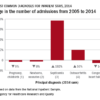News
Pediatric version of SOFA effective
August 7, 2017
Researchers use new Sequential Organ Failure Assessment algorithm to predict death in critically ill children.
![1]()
News
High-flow nasal cannula safe outside of pediatric ICU, but may up length of stay
August 7, 2017
NASHVILLE, TENN. – Children don’t need to be in the PICU for high-flow nasal cannula treatment, at least up to a certain level.
![1]()
Opinion
Student Hospitalist Scholars: Preventing unplanned PICU transfers
July 25, 2017
SHM Student Hospitalist Scholar Farah Hussain wants to help design interventions to prevent pediatric clinical deterioration and unplanned transfers to the PICU.
News
New tool predicts antimicrobial resistance in sepsis
July 19, 2017
Here’s how to predict antibiotic resistance in sepsis patients infected with gram-negative bacteria.
![1]()
News
Plasma biomarker distinguishes ARDS, acute heart failure
July 15, 2017
WASHINGTON – The biomarker identified acute respiratory distress syndrome patients who were sicker and more responsive to conservative fluid management.
![1]()
News
Septicemia admissions almost tripled from 2005 to 2014
July 6, 2017
Septicemia was the most common diagnosis for inpatient stays among those aged 75 years and older.
News
Angiotensin II may improve vasopressors’ efficacy
June 14, 2017
Adding a certain hormone could strengthen treatment options for vasodilatory shock patients.
![1]()
News
Noninvasive therapy cut COPD readmissions
June 7, 2017
WASHINGTON – Noninvasive ventilation therapy may let patients concerned with readmission breathe easy.
![1]()
News
Short Takes
June 5, 2017
Community-based palliative care reduces emergency department visits Retrospective cohort study showed that patients receiving community-based palliative care were less likely to seek ED care. The reduction was greater for older patients and for patients living in areas of higher socioec...
![1]()
Video
VIDEO: Software predicts septic shock in hospitalized patients
May 30, 2017
Algorithm will have a moderate level of sensitivity to avoid “alert fatigue.”






